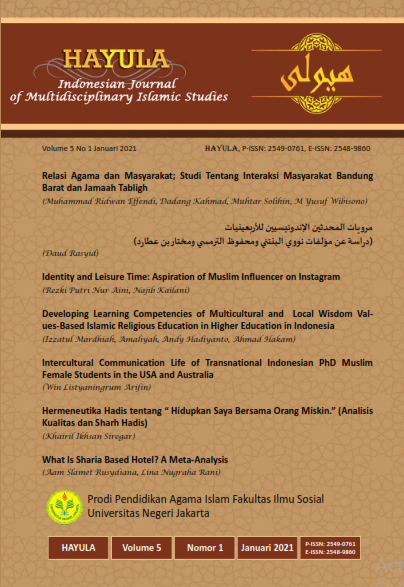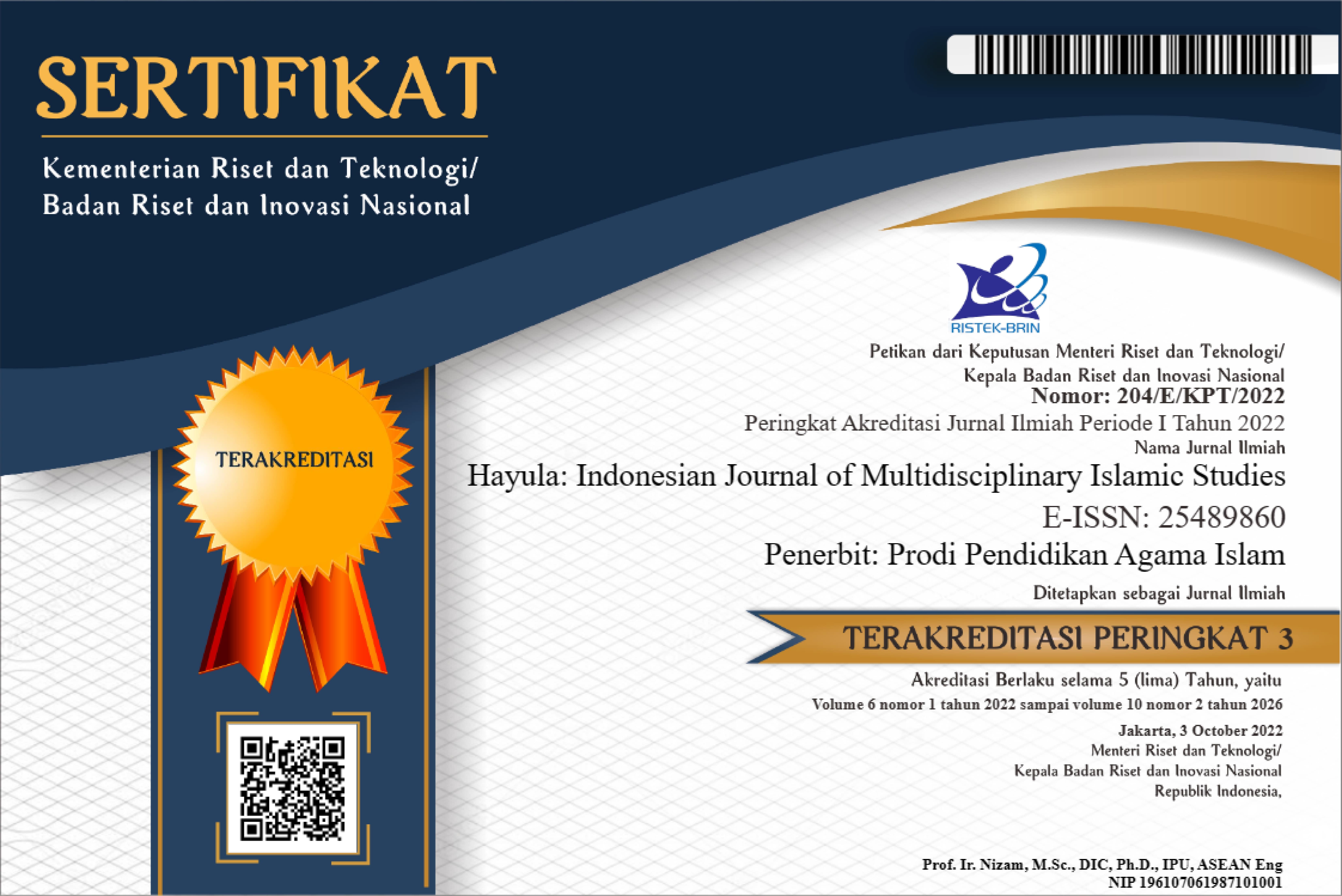Identity and Leisure Time: Aspiration of Muslim Influencers on Instagram
Identitas dan Waktu Luang: Aspirasi Influencer Muslim di Instagram
DOI:
https://doi.org/10.21009/005.01.03Keywords:
Keywords: aspirations; committed Muslim influencer identity; leisure time; Muslimist influencer; negotiationAbstract
Abstract
This paper analyzes the segmentation of identity and aspirations through the discourse of leisure time carried by Indonesian Muslim influencers as a representation of the negotiation efforts of the Muslim middle class society towards the orientation of religious understanding and popular culture within the framework of modernization. The inevitability of differences in religious understanding among these Muslim influencers ultimately influenced them in representing any discourse carried through new media, including leisure time. The neglected leisure time, its neglected role, is one of the determinants of the new style of Muslim identity when this is deliberately exhibited through various social media platforms. This study is important to see the extent of segmentation due to new identities and aspirations through leisure time that these Muslim influencers want to channel massively on social media, especially Instagram. This study was conduct through netnographic studies supported by various available relevant literature. The results of the study indicate that there are two major segmentation trends among Muslim influencers today through discourse on social media, they are committed Muslim influencers and Muslimist influencers, each of which has different identities and new aspirations in leisure time discourse based on contradiction of mutual religious understanding between them.
References
Abdurrahman, Moeslim. (2009b). Bersujud di Baitullah: Ibadah Haji, Mencari Kesalehan Hidup. Penerbit Buku Kompas.
Abidin, Crystal. (2016a). Visibility Labour: Engaging with Influencers’ Fashion Brands and #OOTD Advertorial Campaigns on Instagram. Media International Australia 161, (1).
Addini, Agnia. (2019a). Fenomena Gerakan Hijrah di Kalangan Pemuda Muslim Sebagai Mode Sosial. Journal of Islamic Civilization, Vol. 1, No. 2.
Annisa, Firly. (2018b). Hijrah Millenial: Antara Kesalehan dan Populism. Ma’arif Institute, Vol. 13(No. 1).
Barlas, Asma. (2001). The Qur’an and Hermeneutics: Reading the Qur’an’s Opposition to Patriarchy. Edinburgh University Press, Vol. 3, No. 2.
Baulch, Emma & Parmiyanti, Alila. (2018a). Hijabers on Instagram: Using Visual Social Media to Construct the Ideal Muslim Woman. SAGE, Social Media + Society.
Bayat, Asef. (2007a). Islam and Democracy: What is the Real Question? Amsterdam University Press.
Bayat, Asef. (2007b). Islamism and the Politics of Fun. Public Culture, 19 (3). https://doi.org/10.1215/08992363-2007-004.
Beng-Huat, Chua. (2000b). Consumption in Asia: Lifestyles and Identities. The New Rich in Asia.
Beta, Annisa R. (2019b). Commerce, Piety and Politics: Indonesian Young Muslim Women’s Group as Religious Influencers. SAGE, New Media and Society.
Braidotti, Rosi. (2002b). Cyberfeminism with a difference. Rowman & Littlefield Publishers.
Brenner, Suzanne. (1996). Reconstructing Self and Society: Javanese Muslim Women and the Veil. American Ethnologist, 23 (4).
Cevik, Neslihan. (2016d). Muslimism in Turkey and Beyond: Religion in the Modern World. Palgrave Macmillan.
Chaplin, Charlie. (1936). Tempos Modernos (Modern Times) [Drama Komedi]. Dominio Publico.
Deeb, Lara & Harb, Mona. (2013c). Leisurely Islam: Negotiating Geography and Morality in Shi’ite South Beirut. Princeton University Press.
Embong, Abdul Rahman. (2002a). State-led Modernization and the New Middle Class in Malaysia. Palgrave Macmillan.
Fischer, Johan. (2011). Proper Islamic Consumption: Shopping among the Malays in Modern Malaysia (Book Reviews). American Anthropological Association, Vol. 113(No. 1).
Grenny, Joseph. (2013b). Influencer: The New Science of Leading Change (Second Edition). McGraw-Hill Education.
Hasan, Noorhaidi. (2009c). The Making of Public Islam: Piety, Agency, and Commodification on the Landscape of the Indonesian Public Sphere. Springer.
Hasbullah, Moeflich. (2000c). Cultural Presentation of the Muslim Middle Class in Contemporary Indonesia. STUDIA ISLAMIKA: Indonesia Journal for Islamic Studies, Vol. 7 No. 2.
Heryanto, Ariel. Translated by Eric Sasono. (2015a). Identitas dan Kenikmatan: Politik Budaya Layar Indonesia. KPG (Kepustakaan Populer Gramedia).
Hine, Christine. (2000a). Virtual Ethnography. SAGE Publication Ltd.
Hunnicutt, Benjamin K. (2006). The History of Western Leisure. A Handbook of Leisure Studies.
Kailani, Najib & Sunarwoto. (2019d). Televangelisme Islam dalam Lanskap Otoritas Keagamaan Baru. In Ulama dan Negara-Bangsa: Membaca Masa Depan Islam Politik di Indonesia, Penyunt. Noorhaidi Hasan. Pusat Pengkajian Islam, Demokrasi, dan Perdamaian (PusPIDeP).
Kailani, Najib. (2020b). (Ed.), Articulations of Islam and Muslim Subjectivity: Fundamental Debates in the Anthropology of Islam. In Commerce, Knowledge, and Faith: Islamization of the Modern Indonesian and Han-speaking Muslim Ummahs. Center for Multicultural Studies, College of Liberal Arts.
Khumairoh, Izmy. (2018c). Instadakwah: Redefinisi Kesalehan Perempuan Muslim di Bandung Lewat Mediatisasi Ajaran Agama Islam di Instagram. Jurnal Universitas Gadjah Mada, IV/3.
Kim, Seung-Kuk. (2000d). Changing Lifestyles and Consumption Patterns of the South Korean Middle Class and New Generations. Consumption in Asia: Lifestyles and Identities.
Kozinets, Robert V. (2009d). Netnography: Doing Ethnographic Research Online. SAGE Publication Ltd.
Mariampolski, H. (1999). The Power of Ethnography. International Joural of Market Research, XI/1.
Martin, William H. & Mason, Sandra. (2004). Leisure in an Islamic Context. Taylor & Francis, No. 1(Philosphy of Leisure).
McRobbie, Angela. (2009a). The Aftermath of Feminism: Gender, Culture and Social Change. SAGE Publication.
Mietzner, Marcus & Muhtadi, Burhanuddin. (2018d). Explaining the 2016 Islamist Mobilisation in Indonesia: Religious Intolerance, Militant Groups and the Politics of Accommodation. Asian Studies Review, Vol. 42 (3).
Nancy, K Baym. & Danah, Boyd. (2012). Socially Mediated Publicness: An Introduction. Journal of Broadcasting & Electronic Media, Vol. 56, No. 3.
Rakhmani, Inayah. (2016b). Mainstreaming Islam in Indonesia: Television, Identity, and the Middle Class. Palgrave Macmillan.
Raun, Tobias. (2018f). Capitalizing Intimacy: New Subcultural Forms of Micro-Celebrity Strategies and Affective Labor on YouTube. London: SAGE Publication, Vol. 24, No. 1.
Ridho, Subkhi. (2017). Kelas Menengah Muslim Baru dan Kontestasi Wacana Pluralisme di Media Sosial. Vol. 4, No. 2(Jurnal Pemikiran Sosiologi).
Ridho, Subkhi. (2018e). Pesan Instant Muslimah Kelas Menengah Baru: Studi Identitas Islam di Group Whatsapp ‘Islam’. Ma’arif Institute, Vol. 13, No. 1.
Rofhani, Rofhani. (2013d). Budaya Urban Muslim Kelas Menengah. Teosofi: Jurnal Tasawuf Dan Pemikiran Islam, Vol. 3(No. 1).
Sakai, Minako & Fauzia, Amalia. (2016c). Performing Muslim Womanhood: Muslim Business Women Moderating Islamic Practices in Contemporary Indonesia. Islam and Christian-Muslim Relations, Vol. 27(3).
Sakai, Minako. (2014a). Establishing Social Justice Through Financial Inclusivity: Islamic Propagation by Islamic Savings and Credit Cooperatives in Indonesia. TRANS: Trans-Regional and National Studies of Southeast Asia, Vol. 2(Issue 02).
Wallman, Sandra. (1979). Social Anthropology of Work. Academic Press.
Ward, Pete. (2020c). Celebrity Worship. Routledge: Taylor & Francis Group.
Wieringa, Saskia Eleonora. (2015b). Gender Harmony and The Happy Family: Islam, Gender and Sexuality in Post- Reformasi Indonesia. South East Asia Research 23 (1).
Wynne, Derek. (1998). Leisure, Lifestyle and the New Middle Class: A Case Study. Routledge: Taylor & Francis Group.
Yusuf, Muhammad Fahrudin. (2019c). Dakwah Simbolik Hijrah dan Moderasi Islam di Media Online. Jurnal Aqlam: Journal of Islam and Plurality, Vol. 4, No. 2.
Website and Social Media:
(431) Analisa Channel—YouTube. (2020). Retrieved 1 September 2020, from https://www.youtube.com/user/analisa431
Analisa Personality Development Center (APDC) | LinkedIn. (n.d.). Retrieved 1 September 2020, from https://id.linkedin.com/company/analisa-personality-development-center-apdc
Analisa Widyaningrum (@analisa.widyaningrum) • Instagram photos and videos. (n.d.). Retrieved 3 January 2021, from https://www.instagram.com/analisa.widyaningrum/
Anandito Dwis. (2020). In Wikipedia bahasa Indonesia, ensiklopedia bebas. https://id.wikipedia.org/w/index.php?title=Anandito_Dwis&oldid=17305785
Anandito Dwis (@ananditodwis) • Instagram photos and videos. (2020). Retrieved 3 January 2021, from https://www.instagram.com/ananditodwis/
Anisa Rahma Adi (@anisarahma_12) • Instagram photos and videos. (2020). Retrieved 3 January 2021, from https://www.instagram.com/anisarahma_12/
Anisa Rahma dan Anandito Menikah, Hubungan Berawal dari Proyek Singlelillah. (2018). Tribun Jabar. Retrieved 28 June 2020, from https://jabar.tribunnews.com/2018/09/17/anisa-rahma-dan-anandito-menikah-hubungan-berawal-dari-proyek-singlelillah
Biografi Anisa Rahma mulai dari Masa Kecil, Karir hingga Kehidupan Pribadi—WowKeren.com. (2020). Retrieved 17 September 2020, from https://www.wowkeren.com/seleb/anisa_rahma/bio.html
Carrieri, Alexandre de Padua; Diniz, Ana Paula Rodrigues; de Souza, Elolslo Moulin & Menezes, Raquel Santos Soares. (2013a). Gender and Work: Representations of Femininities and Masculinities in the View of Women Brazilian Executives. Http://Www.Anpad.Org.Br/Bar, Vol. 10(No. 3).
Dari Seksi sampai Berhijab, 6 Transformasi Anisa Rahma Eks Cherrybelle—MataMata.com. (2020). Retrieved 3 January 2021, from https://www.matamata.com/life/2019/10/12/201500/dari-seksi-sampai-berhijab-6-transformasi-anisa-rahma-eks-cherrybelle
Femalepreneur Indonesia. (n.d.). Retrieved 1 September 2020, from https://femalepreneur.id/intip-12-influencer-perempuan-berpengaruh-di-indonesia
Kisah Analisa Widyaningrum, Psikolog Cantik yang Bertekad Kembangkan Kepribadian Kaum Milenial | jadiberita.com. (2017, November 19). https://jadiberita.com/120924/kisah-analisa-widyaningrum-psikolog-cantik-yang-bertekad-kembangkan-kepribadian-kaum-milenial.html
Kompasiana.com. (2013, April 14). Apa itu Muslim yang Kaffah? KOMPASIANA. https://www.kompasiana.com/nanangrosidi/552b835e6ea834767d8b456e/apa-itu-muslim-yang-kaffah
Media, Kompas Cyber. (2020). Girlband Cherrybelle Reunian dari Rumah Masing-masing, ke Mana Sarwendah? Halaman all. KOMPAS.com. Retrieved 18 September 2020, from https://www.kompas.com/hype/read/2020/04/16/171054566/girlband-cherrybelle-reunian-dari-rumah-masing-masing-ke-mana-sarwendah
Putri, S. (2020). Ayu Tenan, Ini Potret Psikolog Cantik Berhijab asal Yogyakarta. wolipop. Retrieved 18 September 2020, from https://wolipop.detik.com/foto-hijab/d-4168941/ayu-tenan-ini-potret-psikolog-cantik-berhijab-asal-yogyakarta
Sarah Sechan—Analisa Widyaningrum Inspirator Muda penerima beasiswa Djarum. (2013). Retrieved 1 September 2020, from https://www.youtube.com/watch?v=uC8FLFJjvyc
Sulistyawati, Rr Laeny & Sasongko, Agung. (2014b, Oktober). Empat Tipe Konsumen Kelas Menengah Muslim di Indonesia [Berita Ekonomi]. Republika. https://republika.co.id/berita/ekonomi/syariah-ekonomi/14/10/26/ne298r-empat-tipe-konsumen-kelas-menengah-muslim-di-indonesia
Downloads
Published
How to Cite
Issue
Section
License
Authors who publish with this Journal agree to the following terms:
- Author retain copyright and grant the journal right of first publication with the work simultaneously licensed under a creative commons attribution licensethat allow others to share the work within an acknowledgement of the work’s authorship and initial publication of this journal.
- Authors are able to enter into separate, additional contractual arrangementfor the non-exclusive distribution of the journal’s published version of the work (e.g. acknowledgement of its initial publication in this journal).
- Authors are permitted and encouraged to post their work online(e.g. in institutional repositories or on their websites) prior to and during the submission process, as it can lead to productive exchanges, as well as earlier and greater citation of published works.
Users/public use of this website will be licensed to CC BY







